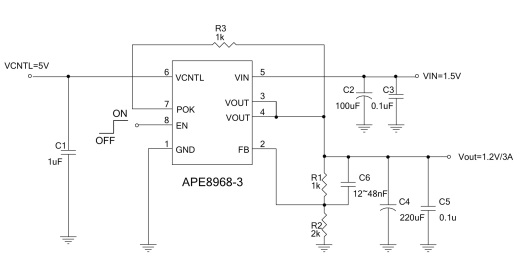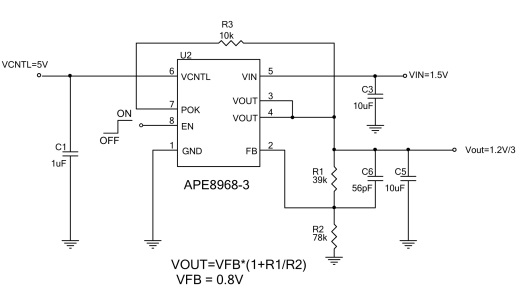BY RALPH WAGGITT
Advanced Power Electronics
www.a-powerusa.com
The switching-versus-linear regulators debate is rather like ac versus dc power. Most people take it to be about which is best, and that has been decided, so discussion over. The traditional, widely held view is that linear regulators may be simple and low cost but are also inefficient; therefore really only suitable for lower-cost applications where efficiency isn’t critical, where loads are light, or when desired output voltage is already close to the input voltage. For many applications, switching regulators are used and their disadvantages — extra supporting components, additional complexity, and higher cost — have been accepted in the quest for efficiency. However, new developments in linear regulators coupled with other factors are combining to challenge the status quo, and now is an opportune time to revisit this issue.
Going back to basics, the resistance of the series pass transistor in a linear regulator varies with the input voltage to create a constant output voltage. The difference between the input voltage and the required output is dissipated as heat in the pass transistor. The output voltage of the linear regulator will always be lower than the input voltage, and the minimum difference between the two — known as the dropout voltage — used to have to be at least 1.5 V for the linear regulator to maintain regulation. The input voltage must be high enough to ensure this minimum difference.
However, technology has advanced and huge voltage differences are no longer the norm, as many boards today have far lower voltage rails than previously seen — the highest rail on a board today might be only 3.3 V. With the presence of flash memory, processors, microcontrollers, and ASICs, rail requirements are likely to be 1.8 V, 1.2 V, or even less than 1 V, so the range of voltages requiring regulation has been significantly compressed. So, some designs now might not need a switching device at all, as efficient regulation at these various voltage requirements may be achievable using modern linear devices.
A major reason for this is the improved performance of devices used in today’s circuits. The key element in a linear regulator is the series pass transistor, and with modern MOSFET technology, this can be a very efficient, highly compact MOSFET device with very low on-resistance, and this directly impacts the dropout voltage. For many years, devices with 1.4-V dropout had been considered as low-dropout regulators. Improvements in MOSFET technology have been so dramatic that dropout voltages today can be as low as a few hundred millivolts, even at substantial load currents. This now enables them to operate effectively in applications where input and output voltages are quite close. In these cases, today’s linear regulators can achieve 85% to 87% efficiency.
Among these so-called ultra-low dropout linear regulators is Advanced Power’s recently-released APE 8968MP-HF-3 series (see Figs. 1 and 2 ) — a 3-A linear regulator that works in applications where input and output voltage are as close as 300 mV. Designed to provide simple PoL dc/dc conversion in board-level applications, including motherboard and notebook applications, it requires two supply voltages, one for the control circuitry to ensure adequate bias to the MOSFET and the other for the main supply. It provides a typical dropout of just 0.23 V at 3 A.

Fig. 1: Supply for main supply.

Fig. 2: Supply for the control circuitry ensures adequate bias for the MOSFETs.
It is easy to forget that linear regulators have always offered certain other advantages over switching regulators in specific circumstances. For example, for light loads or where required output voltage is close to the input voltage, a linear regulator is likely to dissipate less power in the form of heat than a switching regulator. Noise is another consideration, especially in signal-laden applications and personal medical devices where it is becoming increasingly important. Switching regulators need filter components to remove the switching frequency, perhaps anywhere from 300 kHz to 1.5 MHz, which add cost and take up space on the board. As a linear regulator doesn’t switch, the noise floor is inherently lower. This reduces component count and saves cost, plus the device is likely to be more reliable. As a simpler and smaller device, linear regulators can save board space and weight as well.
All engineering decisions are a trade-off, and in real life, engineers have to decide the best return for their design in terms of system performance, system cost, speed and development. Obviously, for step-up or boost, linear regulators are not an option as they can only step down. In areas such as battery applications and hand-held devices, where battery life between recharges and efficiency may be the number one priority, a switching regulator may very well be the best and only solution. But there are many other applications where efficiency in the 85% to 87% range is an acceptable number, especially when considered against the significant increase in cost for a switching regulator chip versus a linear regulator chip. Also, the much smaller component count and therefore higher reliability obtainable with a linear regulator can be an important consideration.
Linear regulators do not fit every possible scenario, but the impact of all the advances discussed — lower rail voltages, MOSFET performance, and improvements to both linear regulators themselves and to other devices in the circuit — means that engineers can now take a fresh look at linear regulators as a solutions opportunity.
Advertisement
Learn more about Advanced Power Electronics





